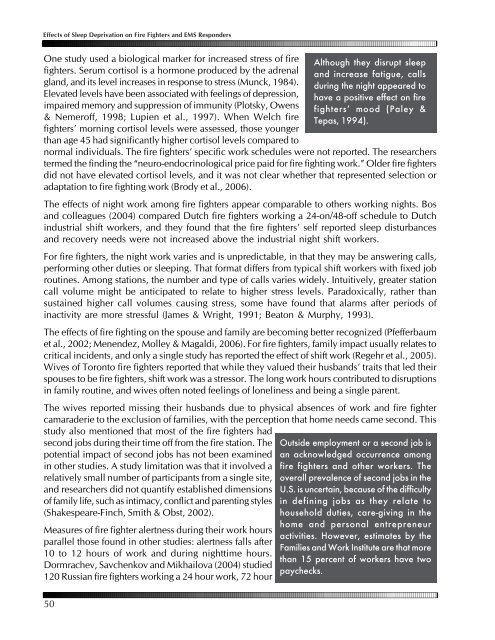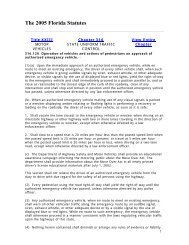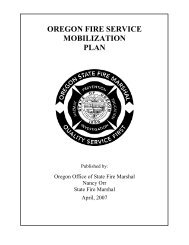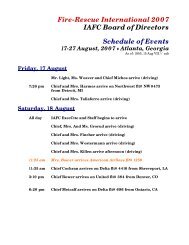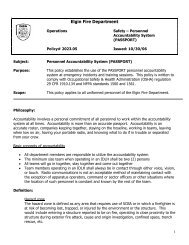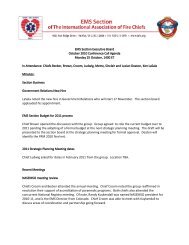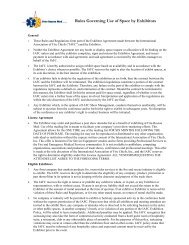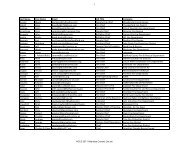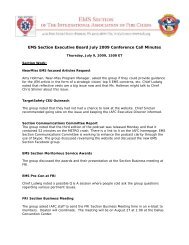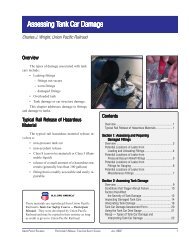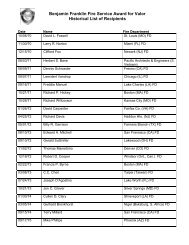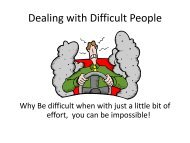Effects of Sleep Deprivation on Fire Fighters and EMS ... - NAEMT
Effects of Sleep Deprivation on Fire Fighters and EMS ... - NAEMT
Effects of Sleep Deprivation on Fire Fighters and EMS ... - NAEMT
You also want an ePaper? Increase the reach of your titles
YUMPU automatically turns print PDFs into web optimized ePapers that Google loves.
<str<strong>on</strong>g>Effects</str<strong>on</strong>g> <str<strong>on</strong>g>of</str<strong>on</strong>g> <str<strong>on</strong>g>Sleep</str<strong>on</strong>g> <str<strong>on</strong>g>Deprivati<strong>on</strong></str<strong>on</strong>g> <strong>on</strong> <strong>Fire</strong> <strong>Fighters</strong> <strong>and</strong> <strong>EMS</strong> Resp<strong>on</strong>ders<br />
One study used a biological marker for increased stress <str<strong>on</strong>g>of</str<strong>on</strong>g> fire<br />
fighters. Serum cortisol is a horm<strong>on</strong>e produced by the adrenal<br />
gl<strong>and</strong>, <strong>and</strong> its level increases in resp<strong>on</strong>se to stress (Munck, 1984).<br />
Elevated levels have been associated with feelings <str<strong>on</strong>g>of</str<strong>on</strong>g> depressi<strong>on</strong>,<br />
impaired memory <strong>and</strong> suppressi<strong>on</strong> <str<strong>on</strong>g>of</str<strong>on</strong>g> immunity (Plotsky, Owens<br />
& Nemer<str<strong>on</strong>g>of</str<strong>on</strong>g>f, 1998; Lupien et al., 1997). When Welch fire<br />
fighters’ morning cortisol levels were assessed, those younger<br />
than age 45 had significantly higher cortisol levels compared to<br />
normal individuals. The fire fighters’ specific work schedules were not reported. The researchers<br />
termed the finding the “neuro-endocrinological price paid for fire fighting work.” Older fire fighters<br />
did not have elevated cortisol levels, <strong>and</strong> it was not clear whether that represented selecti<strong>on</strong> or<br />
adaptati<strong>on</strong> to fire fighting work (Brody et al., 2006).<br />
The effects <str<strong>on</strong>g>of</str<strong>on</strong>g> night work am<strong>on</strong>g fire fighters appear comparable to others working nights. Bos<br />
<strong>and</strong> colleagues (2004) compared Dutch fire fighters working a 24-<strong>on</strong>/48-<str<strong>on</strong>g>of</str<strong>on</strong>g>f schedule to Dutch<br />
industrial shift workers, <strong>and</strong> they found that the fire fighters’ self reported sleep disturbances<br />
<strong>and</strong> recovery needs were not increased above the industrial night shift workers.<br />
For fire fighters, the night work varies <strong>and</strong> is unpredictable, in that they may be answering calls,<br />
performing other duties or sleeping. That format differs from typical shift workers with fixed job<br />
routines. Am<strong>on</strong>g stati<strong>on</strong>s, the number <strong>and</strong> type <str<strong>on</strong>g>of</str<strong>on</strong>g> calls varies widely. Intuitively, greater stati<strong>on</strong><br />
call volume might be anticipated to relate to higher stress levels. Paradoxically, rather than<br />
sustained higher call volumes causing stress, some have found that alarms after periods <str<strong>on</strong>g>of</str<strong>on</strong>g><br />
inactivity are more stressful (James & Wright, 1991; Beat<strong>on</strong> & Murphy, 1993).<br />
The effects <str<strong>on</strong>g>of</str<strong>on</strong>g> fire fighting <strong>on</strong> the spouse <strong>and</strong> family are becoming better recognized (Pfefferbaum<br />
et al., 2002; Menendez, Molley & Magaldi, 2006). For fire fighters, family impact usually relates to<br />
critical incidents, <strong>and</strong> <strong>on</strong>ly a single study has reported the effect <str<strong>on</strong>g>of</str<strong>on</strong>g> shift work (Regehr et al., 2005).<br />
Wives <str<strong>on</strong>g>of</str<strong>on</strong>g> Tor<strong>on</strong>to fire fighters reported that while they valued their husb<strong>and</strong>s’ traits that led their<br />
spouses to be fire fighters, shift work was a stressor. The l<strong>on</strong>g work hours c<strong>on</strong>tributed to disrupti<strong>on</strong>s<br />
in family routine, <strong>and</strong> wives <str<strong>on</strong>g>of</str<strong>on</strong>g>ten noted feelings <str<strong>on</strong>g>of</str<strong>on</strong>g> l<strong>on</strong>eliness <strong>and</strong> being a single parent.<br />
The wives reported missing their husb<strong>and</strong>s due to physical absences <str<strong>on</strong>g>of</str<strong>on</strong>g> work <strong>and</strong> fire fighter<br />
camaraderie to the exclusi<strong>on</strong> <str<strong>on</strong>g>of</str<strong>on</strong>g> families, with the percepti<strong>on</strong> that home needs came sec<strong>on</strong>d. This<br />
study also menti<strong>on</strong>ed that most <str<strong>on</strong>g>of</str<strong>on</strong>g> the fire fighters had<br />
sec<strong>on</strong>d jobs during their time <str<strong>on</strong>g>of</str<strong>on</strong>g>f from the fire stati<strong>on</strong>. The<br />
potential impact <str<strong>on</strong>g>of</str<strong>on</strong>g> sec<strong>on</strong>d jobs has not been examined<br />
in other studies. A study limitati<strong>on</strong> was that it involved a<br />
relatively small number <str<strong>on</strong>g>of</str<strong>on</strong>g> participants from a single site,<br />
<strong>and</strong> researchers did not quantify established dimensi<strong>on</strong>s<br />
<str<strong>on</strong>g>of</str<strong>on</strong>g> family life, such as intimacy, c<strong>on</strong>flict <strong>and</strong> parenting styles<br />
(Shakespeare-Finch, Smith & Obst, 2002).<br />
Measures <str<strong>on</strong>g>of</str<strong>on</strong>g> fire fighter alertness during their work hours<br />
parallel those found in other studies: alertness falls after<br />
10 to 12 hours <str<strong>on</strong>g>of</str<strong>on</strong>g> work <strong>and</strong> during nighttime hours.<br />
Dormrachev, Savchenkov <strong>and</strong> Mikhailova (2004) studied<br />
120 Russian fire fighters working a 24 hour work, 72 hour<br />
Although they disrupt sleep<br />
<strong>and</strong> increase fatigue, calls<br />
during the night appeared to<br />
have a positive effect <strong>on</strong> fire<br />
fighters’ mood (Paley &<br />
Tepas, 1994).<br />
Outside employment or a sec<strong>on</strong>d job is<br />
an acknowledged occurrence am<strong>on</strong>g<br />
fire fighters <strong>and</strong> other workers. The<br />
overall prevalence <str<strong>on</strong>g>of</str<strong>on</strong>g> sec<strong>on</strong>d jobs in the<br />
U.S. is uncertain, because <str<strong>on</strong>g>of</str<strong>on</strong>g> the difficulty<br />
in defining jobs as they relate to<br />
household duties, care-giving in the<br />
home <strong>and</strong> pers<strong>on</strong>al entrepreneur<br />
activities. However, estimates by the<br />
Families <strong>and</strong> Work Institute are that more<br />
than 15 percent <str<strong>on</strong>g>of</str<strong>on</strong>g> workers have two<br />
paychecks.<br />
50


